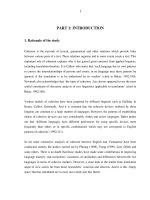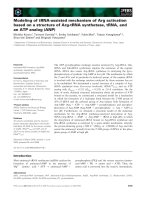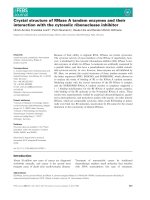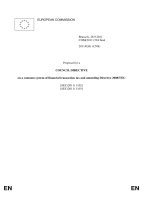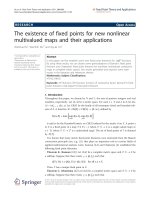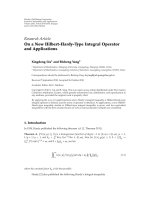IFRIC Interpretation 14: IAS 19 - The limit on a defined benefit asset, minimum funding requirements and their interaction
Bạn đang xem bản rút gọn của tài liệu. Xem và tải ngay bản đầy đủ của tài liệu tại đây (54.28 KB, 8 trang )
IFRIC 14
IFRIC Interpretation 14
IAS 19—
The Limit on a Defined Benefit Asset,
Minimum Funding Requirements and
their Interaction
This version includes amendments resulting from IFRSs issued up to 31 December 2008.
IFRIC 14 IAS 19—The Limit on a Defined Benefit Asset, Minimum Funding Requirements and their
Interaction was developed by the International Financial Reporting Interpretations
Committee and issued by the International Accounting Standards Board in July 2007.
IFRIC 14 and its accompanying documents have been amended by IAS 1 Presentation of
Financial Statements (as revised in September 2007).*
*
effective date 1 January 2009
©
IASCF
2589
IFRIC 14
CONTENTS
paragraphs
IFRIC INTERPRETATION 14
IAS 19—THE LIMIT ON A DEFINED BENEFIT ASSET, MINIMUM
FUNDING REQUIREMENTS AND THEIR INTERACTION
REFERENCES
BACKGROUND
1–3
SCOPE
4–5
ISSUES
6
CONSENSUS
7–26
Availability of a refund or reduction in future contributions
7–17
The effect of a minimum funding requirement on the economic benefit
available as a reduction in future contributions
18–22
When a minimum funding requirement may give rise to a liability
23–26
EFFECTIVE DATE
27–27A
TRANSITION
28
ILLUSTRATIVE EXAMPLES
BASIS FOR CONCLUSIONS
2590
©
IASCF
IFRIC 14
IFRIC Interpretation 14 IAS 19—The Limit on a Defined Benefit Asset, Minimum Funding
Requirements and their Interaction (IFRIC 14) is set out in paragraphs 1–28. IFRIC 14 is
accompanied by Illustrative Examples and a Basis for Conclusions. The scope and
authority of Interpretations are set out in paragraphs 2 and 7–17 of the Preface to
International Financial Reporting Standards.
©
IASCF
2591
IFRIC 14
IFRIC Interpretation 14
IAS 19—The Limit on a Defined Benefit Asset, Minimum
Funding Requirements and their Interaction
References
•
IAS 1 Presentation of Financial Statements
•
IAS 8 Accounting Policies, Changes in Accounting Estimates and Errors
•
IAS 19 Employee Benefits
•
IAS 37 Provisions, Contingent Liabilities and Contingent Assets
Background
1
Paragraph 58 of IAS 19 limits the measurement of a defined benefit asset to ‘the
present value of economic benefits available in the form of refunds from the plan
or reductions in future contributions to the plan’ plus unrecognised gains and
losses. Questions have arisen about when refunds or reductions in future
contributions should be regarded as available, particularly when a minimum
funding requirement exists.
2
Minimum funding requirements exist in many countries to improve the security
of the post-employment benefit promise made to members of an employee
benefit plan. Such requirements normally stipulate a minimum amount or level
of contributions that must be made to a plan over a given period. Therefore, a
minimum funding requirement may limit the ability of the entity to reduce
future contributions.
3
Further, the limit on the measurement of a defined benefit asset may cause a
minimum funding requirement to be onerous. Normally, a requirement to make
contributions to a plan would not affect the measurement of the defined benefit
asset or liability. This is because the contributions, once paid, will become plan
assets and so the additional net liability is nil. However, a minimum funding
requirement may give rise to a liability if the required contributions will not be
available to the entity once they have been paid.
Scope
4
This Interpretation applies to all post-employment defined benefits and other
long-term employee defined benefits.
5
For the purpose of this Interpretation, minimum funding requirements are any
requirements to fund a post-employment or other long-term defined benefit plan.
2592
©
IASCF
IFRIC 14
Issues
6
The issues addressed in this Interpretation are:
(a)
when refunds or reductions in future contributions should be regarded as
available in accordance with paragraph 58 of IAS 19.
(b)
how a minimum funding requirement might affect the availability of
reductions in future contributions.
(c)
when a minimum funding requirement might give rise to a liability.
Consensus
Availability of a refund or reduction in future contributions
7
An entity shall determine the availability of a refund or a reduction in future
contributions in accordance with the terms and conditions of the plan and any
statutory requirements in the jurisdiction of the plan.
8
An economic benefit, in the form of a refund or a reduction in future
contributions, is available if the entity can realise it at some point during the life
of the plan or when the plan liabilities are settled. In particular, such an
economic benefit may be available even if it is not realisable immediately at the
end of the reporting period.
9
The economic benefit available does not depend on how the entity intends to use
the surplus. An entity shall determine the maximum economic benefit that is
available from refunds, reductions in future contributions or a combination of
both. An entity shall not recognise economic benefits from a combination of
refunds and reductions in future contributions based on assumptions that are
mutually exclusive.
10
In accordance with IAS 1, the entity shall disclose information about the key
sources of estimation uncertainty at the end of the reporting period that have a
significant risk of causing a material adjustment to the carrying amount of the
net asset or liability recognised in the statement of financial position. This might
include disclosure of any restrictions on the current realisability of the surplus or
disclosure of the basis used to determine the amount of the economic benefit
available.
The economic benefit available as a refund
The right to a refund
11
A refund is available to an entity only if the entity has an unconditional right to
a refund:
(a)
during the life of the plan, without assuming that the plan liabilities must
be settled in order to obtain the refund (eg in some jurisdictions, the entity
may have a right to a refund during the life of the plan, irrespective of
whether the plan liabilities are settled); or
©
IASCF
2593
IFRIC 14
(b)
assuming the gradual settlement of the plan liabilities over time until all
members have left the plan; or
(c)
assuming the full settlement of the plan liabilities in a single event (ie as a
plan wind-up).
An unconditional right to a refund can exist whatever the funding level of a plan
at the end of the reporting period.
12
If the entity’s right to a refund of a surplus depends on the occurrence or
non-occurrence of one or more uncertain future events not wholly within its
control, the entity does not have an unconditional right and shall not recognise
an asset.
Measurement of the economic benefit
13
An entity shall measure the economic benefit available as a refund as the amount
of the surplus at the end of the reporting period (being the fair value of the plan
assets less the present value of the defined benefit obligation) that the entity has
a right to receive as a refund, less any associated costs. For instance, if a refund
would be subject to a tax other than income tax, an entity shall measure the
amount of the refund net of the tax.
14
In measuring the amount of a refund available when the plan is wound up
(paragraph 11(c)), an entity shall include the costs to the plan of settling the plan
liabilities and making the refund. For example, an entity shall deduct professional
fees if these are paid by the plan rather than the entity, and the costs of any
insurance premiums that may be required to secure the liability on wind-up.
15
If the amount of a refund is determined as the full amount or a proportion of the
surplus, rather than a fixed amount, an entity shall make no adjustment for the
time value of money, even if the refund is realisable only at a future date.
The economic benefit available as a contribution reduction
16
17
2594
If there is no minimum funding requirement, an entity shall determine the
economic benefit available as a reduction in future contributions as the lower of
(a)
the surplus in the plan and
(b)
the present value of the future service cost to the entity, ie excluding any
part of the future cost that will be borne by employees, for each year over
the shorter of the expected life of the plan and the expected life of the
entity.
An entity shall determine the future service costs using assumptions consistent
with those used to determine the defined benefit obligation and with the
situation that exists at the end of the reporting period as determined by IAS 19.
Therefore, an entity shall assume no change to the benefits to be provided by a
plan in the future until the plan is amended and shall assume a stable workforce
in the future unless the entity is demonstrably committed at the end of the
reporting period to make a reduction in the number of employees covered by
©
IASCF
IFRIC 14
the plan. In the latter case, the assumption about the future workforce shall
include the reduction. An entity shall determine the present value of the future
service cost using the same discount rate as that used in the calculation of the
defined benefit obligation at the end of the reporting period.
The effect of a minimum funding requirement on the
economic benefit available as a reduction in future
contributions
18
An entity shall analyse any minimum funding requirement at a given date into
contributions that are required to cover (a) any existing shortfall for past service
on the minimum funding basis and (b) the future accrual of benefits.
19
Contributions to cover any existing shortfall on the minimum funding basis in
respect of services already received do not affect future contributions for future
service. They may give rise to a liability in accordance with paragraphs 23–26.
20
If there is a minimum funding requirement for contributions relating to the
future accrual of benefits, an entity shall determine the economic benefit
available as a reduction in future contributions as the present value of:
(a)
the estimated future service cost in each year in accordance with
paragraphs 16 and 17 less
(b)
the estimated minimum funding contributions required in respect of the
future accrual of benefits in that year.
21
An entity shall calculate the future minimum funding contributions required in
respect of the future accrual of benefits taking into account the effect of any
existing surplus on the minimum funding requirement basis. An entity shall use
the assumptions required by the minimum funding requirement and, for any
factors not specified by the minimum funding requirement, assumptions
consistent with those used to determine the defined benefit obligation and with
the situation that exists at the end of the reporting period as determined by
IAS 19. The calculation shall include any changes expected as a result of the
entity paying the minimum contributions due. However, the calculation shall
not include the effect of expected changes in the terms and conditions of the
minimum funding requirement that are not substantively enacted or
contractually agreed at the end of the reporting period.
22
If the future minimum funding contribution required in respect of the future
accrual of benefits exceeds the future IAS 19 service cost in any given year, the
present value of that excess reduces the amount of the asset available as a
reduction in future contributions at the end of the reporting period. However,
the amount of the asset available as a reduction in future contributions can never
be less than zero.
©
IASCF
2595
IFRIC 14
When a minimum funding requirement may give rise
to a liability
23
If an entity has an obligation under a minimum funding requirement to pay
contributions to cover an existing shortfall on the minimum funding basis in
respect of services already received, the entity shall determine whether the
contributions payable will be available as a refund or reduction in future
contributions after they are paid into the plan.
24
To the extent that the contributions payable will not be available after they are
paid into the plan, the entity shall recognise a liability when the obligation arises.
The liability shall reduce the defined benefit asset or increase the defined benefit
liability so that no gain or loss is expected to result from applying paragraph 58
of IAS 19 when the contributions are paid.
25
An entity shall apply paragraph 58A of IAS 19 before determining the liability in
accordance with paragraph 24.
26
The liability in respect of the minimum funding requirement and any subsequent
remeasurement of that liability shall be recognised immediately in accordance
with the entity’s adopted policy for recognising the effect of the limit in
paragraph 58 in IAS 19 on the measurement of the defined benefit asset.
In particular:
(a)
an entity that recognises the effect of the limit in paragraph 58 in profit or
loss, in accordance with paragraph 61(g) of IAS 19, shall recognise the
adjustment immediately in profit or loss.
(b)
an entity that recognises the effect of the limit in paragraph 58 in other
comprehensive income, in accordance with paragraph 93C of IAS 19, shall
recognise the adjustment immediately in other comprehensive income.
Effective date
27
An entity shall apply this Interpretation for annual periods beginning on or after
1 January 2008. Earlier application is permitted.
27A
IAS 1 (as revised in 2007) amended the terminology used throughout IFRSs.
In addition it amended paragraph 26. An entity shall apply those amendments
for annual periods beginning on or after 1 January 2009. If an entity applies
IAS 1 (revised 2007) for an earlier period, the amendments shall be applied for
that earlier period.
Transition
28
2596
An entity shall apply this Interpretation from the beginning of the first period
presented in the first financial statements to which the Interpretation applies.
An entity shall recognise any initial adjustment arising from the application of
this Interpretation in retained earnings at the beginning of that period.
©
IASCF
